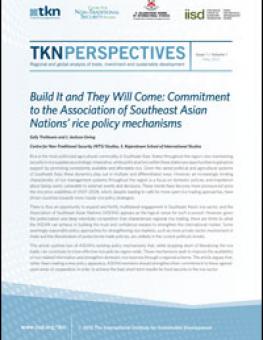
Build It and They Will Come: Commitment to the Association of Southeast Asian Nations' rice policy mechanisms
This article outlines two of ASEAN's existing policy mechanisms that, while stopping short of liberalizing the rice trade, can contribute to more effective rice policies region-wide.
The article argues that, rather than creating a new policy apparatus, ASEAN members should strengthen their commitment to these agreed-upon areas of cooperation in order to achieve the best short-term results for food security in the rice sector
Rice is the most politicized agricultural commodity in Southeast Asia. States throughout the region view maintaining security in rice supplies as a strategic imperative, while political actors within these states see opportunities to galvanize support by promising consistently available and affordable rice. An increasingly binding characteristic of rice management systems throughout the region is a focus on domestic policies and trepidation about being overly vulnerable to external events and decisions. These trends have become more pronounced since the rice price volatilities of 2007-2008, which, despite leading to calls for more open rice trading approaches, have driven countries towards more insular rice policy strategies.
There is thus an opportunity to expand and fortify multilateral engagement in Southeast Asia's rice sector, and the Association of Southeast Asian Nations (ASEAN) appears as the logical venue for such a pursuit. This article outlines two of ASEAN's existing policy mechanisms that, while stopping short of liberalizing the rice trade, can contribute to more effective rice policies region-wide. The article argues that, rather than creating a new policy apparatus, ASEAN members should strengthen their commitment to these agreed-upon areas of cooperation in order to achieve the best short-term results for food security in the rice sector.
You might also be interested in
Britain Becomes First European Member of Trans-Pacific Trade Bloc
The United Kingdom becomes the first new member to join the Comprehensive and Progressive Agreement for Trans-Pacific Partnership (CPTPP) since it entered into force in 2018.
The CPTPP trade deal is a major threat to public health and warrants a health impact assessment
The UK government has joined one of the world’s largest free trade agreements, known as the Comprehensive and Progressive Agreement on Trans-Pacific Partnership (CPTPP). The CPTPP is not a new trade agreement waiting to be negotiated, but an already active one among 11 Pacific Rim countries (Australia, Brunei, Canada, Chile, Japan, Malaysia, Mexico, New Zealand, Peru, Singapore, and Vietnam). Joining the CPTPP commits the UK to several rules concerning trade in goods and services that have important implications for health. Although the US is not a member of the CPTPP, the agreement evolved from the Trans-Pacific Partnership, which initially included—and was shaped by—the US before President Trump withdrew the country from the deal in 2017. As such, many provisions, and even entire chapters, of the CPTPP are near carbon copies of other free trade deals negotiated by the US. But despite how much alarm was raised over the potential health effects of a free trade agreement with the US, there has been little discussion of the public health implications of the UK’s accession to this new deal.